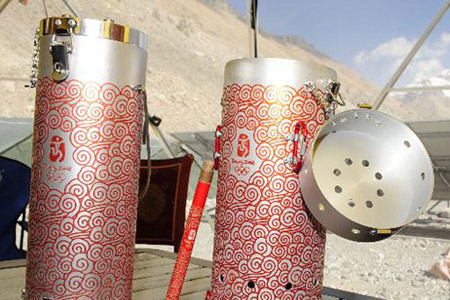An expert with a torch design lab under the China Aerospace Science and Industry Corp. said at the Qomolangma Base Camp on Wednesday that the Olympic torch can scale the summit without sputtering out.

An expert with a torch design lab under the China Aerospace Science and Industry Corp. said at the Qomolangma Base Camp on Wednesday that the Olympic torch can scale the summit without sputtering out.
The ascent of the torch to the Mt. Qomolangma will be one of the highlights of the torch relay for the 2008 Beijing Olympics.
"The torch and the lantern used for the Qomolangma expedition are high-tech ones capable of withstanding gale-force wind, low temperatures and even the oxygen-thin air atop the Mt. Qomolangma," said Gao Bingxin, deputy director of the design lab.
"Some experts argue that the mountaineers will think like five-year-old kids on the world's highest peak, so the lantern and the torch must be easy to handle."
The Olympic flame was lit in ancient Olympia, Greece on March 24. After running through 19 countries on its international tour, the torch arrived in China's Hong Kong on Wednesday. The flame's tour in China includes the Mt. Qomolangma in May and Lhasa, capital of the Tibet Autonomous Region, in June.
On the world's highest peak, ferocious winds and temperatures of minus 30 degrees Celsius (minus 22 Fahrenheit) are the major troubles in lighting the torch, but the Chinese scientist has expressed full confidence in the torch relay.
"The torch was designed specifically and after the tryouts carried out last year, we can say that our torch can stay alight in the tough, oxygen-sparse conditions that leave even experienced climbers struggling, and everyone will be able to see a bright flame."
"I can also assure you that if the Mt. Qomolangma grew higher by 200 meters tomorrow, our torch could still burn at the summit."